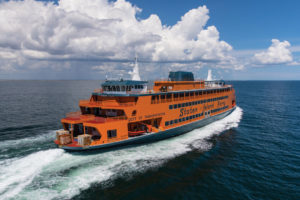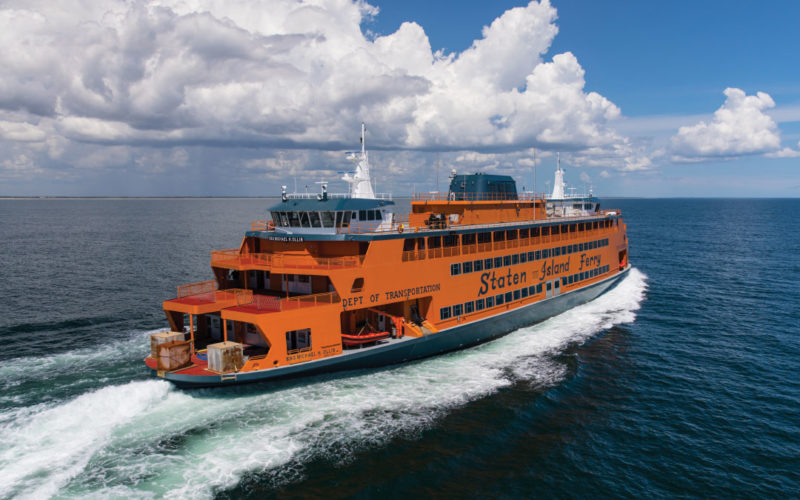
The Staten Island Ferry will soon debut a new class of passenger ferries that will run along the heavily traveled corridor between Manhattan and Staten Island.
SSG Michael H. Ollis is the lead vessel in the series of three ferries designed to carry 4,500 passengers. Eastern Shipbuilding Group (ESG) in Florida built the vessels based on a design from Elliott Bay Design Group of Seattle.
The new ferry left Eastern’s Port St. Joe facility fully certified and passenger-ready, having successfully performed sea trials in the Gulf of Mexico. It traveled from Florida to New York under tow by Dann Ocean Towing’s Colonel and arrived in early August. It is expected to enter service by Christmas following an extensive crew training program.
The lead ferry is named after U.S. Army Staff Sergeant Michael H. Ollis, a war hero and Staten Island native serving his third tour of duty when he was tragically killed at age 24 by a suicide bomber in Afghanistan. The Ollis family remotely attended a christening at Eastern Shipbuilding before the vessel left for New York. The other two ferries in the class are named Sandy Ground and Dorothy Day.
Once all three Ollis-class boats have entered service, the 56-year-old John F. Kennedy and 40-year-old Andrew J. Barberi will be retired. Parts from the latter will extend the life of its sister boat, Samuel I. Newhouse, according to John Garvey, New York City Department of Transportation’s (NYC DOT) deputy commissioner and chief operating officer. NYC DOT opearates the Staten Island Ferry system.
“We tried to take the best from the previous classes and incorporate them into the construction of this one,” Garvey said in an interview. “We tried to have a little bit of forethought as to what might happen down the road.”
The Staten Island Ferry, with its iconic blue and orange colors, is ubiquitous on the New York City waterfront. Operating 24 hours per day and 365 days a year, Staten Island Ferries transit the 5.2-mile route between Whitehall and St. George terminals in about 22 minutes.
The ferries are the only means of mass transit between Staten Island and Manhattan. They make 118 runs each day during the work week, with fewer on weekends. Before the Covid-19 pandemic, the ferry carried up to 25 million people a year, all of whom ride at no charge.
The ferry service budgets 30 minutes for each passage, including the transit and time for passenger loading and unloading. With up to 2,500 people on each crossing, any hiccups during this finely tuned process can upset the schedule for several runs.
Ollis-class ferries are broadly similar to the Barberi class, which has a similar passenger capacity spread across three decks. But the new ships feature notable enhancements in passenger comfort, including better wireless internet and more charging stations. The propulsion system, with EPA Tier 4 EMD engines, is another upgrade.
From an operator’s perspective, one of the biggest improvements is one few passengers will notice. After studying the existing fleet, ferry officials identified how a shorter boarding area on some vessels unnecessarily slowed the boarding process.
“When the passengers come on, they also do a stutter step and stop as they decide which way to go,” Garvey said. “The Kennedy has a longer embarkation area, which allowed them another second or two to keep walking as they made that decision, so that was incorporated into these new vessels.”
Additionally, the interior is open essentially from end to end, creating a better airflow within each deck. It also improves security by eliminating dark corners and obstructions.
The new boats have incorporated popular design elements of past Staten Island Ferries and new customer-service amenities such as a large snack bar. An oval upper-deck promenade will for the first time offer unobstructed fresh-air views of the Manhattan skyline, Ellis Island and the Statue of Liberty. The promenade will also serve as an outdoor “walking track” for ferry riders. Heated decks will eliminate ice and snow build-up during the colder months.
The seating is utilitarian, which is apparently how passengers want it. Ferry riders themselves favored the UES Marine faux wood benches in a public survey that allowed riders to test three prototypes.
Propulsion on the 9,980-hp Ollis-class ferries comes from four EMD engines that meet EPA Tier 4 emissions standards thanks to a selective catalytic reduction aftertreatment system. Two EMD engines are linked through a Reintjes combining reduction gear to a single Voith Schneider cycloidal propeller at each end of the hull.
SSG Michael H. Ollis and its sister ferries will cruise at about 17 knots, roughly a knot faster than the existing vessels. During typical voyages, that translates to extra time at the dock between runs.
“One additional knot over the course of a 5.2-mile route will save us 45 to 50 seconds. And when you only have six minutes to load and unload, it does increase the number of passengers we can accommodate,” Garvey said. “It gives us a little better chance of staying on time with increased ridership.”
More than 18 months into the Covid-19 pandemic, passenger counts are still depressed, particularly during weekday runs. Garvey projected the service will carry about 9 million passengers this year. Although the ferry does not sell tickets, onboard counters let crews know how many people are on board.
Design improvements weren’t limited to passenger spaces. Ollis-class ferries have a larger wheelhouse than other vessels in the fleet, and windows offer better visibility forward. For the first time, captains also will be able to see aft.
The electronics package consists of Furuno and Wartsila navigation equipment, with Icom VHF radios. Weather stations also provide crew with accurate conditions as they make a final approach into the terminal.
Engine controls are automated and can be controlled via a push-button system for different vessel operations, such as start-up, normal transit and flank speed. “They are programmed to minimize vibrations down below,” Garvey said. “It also standardizes the speed across the fleet and helps keep everything on track.”
Ollis-class ferries will run with 15 crewmembers. A typical crew consists of a captain and assistant captain, three mates, six deck hands, a chief engineer and a marine engineer, and two marine oilers. That is a lot of people to train on the new vessels.
Wheelhouse personnel are acclimating to the new ships using a simulator installed in Whitehall Terminal. The ferry service commissioned a full mission bridge simulator with functioning Wartsila and Furuno control panels.
“A lot of operators will use mock-ups,” Garvey said. “We did not. When you go into this simulator, the equipment you are using is the exact equipment that is in the bridge. It is the exact chair, and the exact joysticks and exact layout of the controls and throttles.”
ESG President Joey D’Isernia considers the Ollis-class ferry project a source of pride. The vessels, he added, feature some of the most advanced technology and environmental engineering in the industry.
“It’s been an honor for ESG to build this class named after one of our fallen heroes and deliver state-of-the-art vessels for the world’s busiest passenger ferry route,” he said in a statement. “It is a critical maritime infrastructure project that was proudly built by hardworking American ship designers and builders.”
Based on current timelines, Sandy Ground and Dorothy Day are projected to join the fleet late 2021 and early 2022, respectively.

